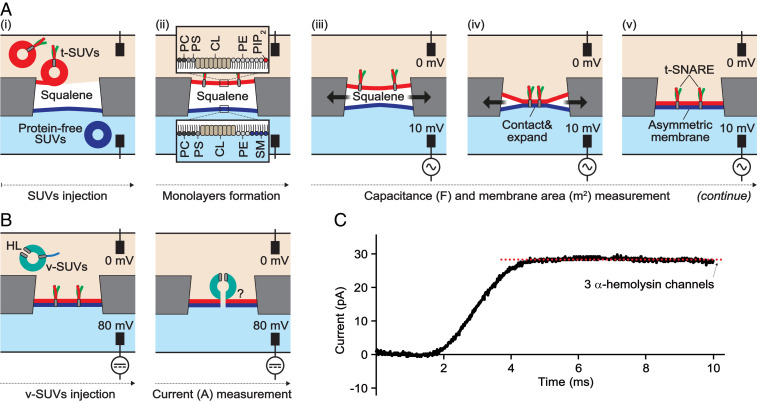Fig. 1.
SNARE-induced pores. (A) The tPLM formation. The formation of the tSNARE-decorated plasma-like membrane is described in the five cartoons. (i) SUVs are flown in two microfluidic channels that are separated by a hole filled beforehand with a 1-nL squalene droplet. The SUVs spread at the oil/buffer interface in each channel, forming a leaflet on each side of the squalene droplet. Each leaflet has the same composition as the corresponding SUVs. (ii) The top leaflet is made of DOPC:DOPS:Cholesterol:DOPE:PIP2 at 7:15:45:30:3% in moles, and the bottom leaflet composition is DOPC:DOPS:Cholesterol:DOPE:Sphingomyelin at 20:5:45:15:15% in moles, resembling the cytosolic and extracellular leaflets of the plasma membrane. In addition, the SUVs circulating in the top channel contained tSNAREs that are also inserted in the leaflet with the desired orientation. (iii) The squalene is absorbed by the chip in ∼1 h, decreasing, progressively, the interleaflet distance. (iv) When a sufficient amount of squalene has been absorbed, the two leaflets contact in the center of the hole and nucleate a bilayer. This nucleation is attested by capacitance measurement (10-mV alternating current). (v) Upon completion of squalene absorption, the suspended asymmetric bilayer with tSNAREs is fully expanded and remains stable for more than 3 h. (B) Fusion pore observation. The vSNARE-decorated vesicles containing protein channels, α-hemolysin heptamers, (vSUVs) are injected, and a constant 80-mV voltage is applied between the two channels. When vSUV fuses with the tPLM, a fusion pore opens. At that point, the presence of the α-hemolysin channels guarantees the continuity of the aqueous medium between the two channels, and the current can be measured at 100 kHz, directly attesting the opening of the fusion pore. (C) Observation of fusion pore opening by current measurement. During the first 2 ms, no current is observed. At 2 ms, a sudden jump in current demonstrates the opening of a fusion pore (red dashed line). Such pore formation is specifically induced by the formation of SNAREpins.

